Systemic Evaluation of the Effects of Regional Self-Supply Targets on the German Electricity System Using Consistent Scenarios and System Optimization
Abstract
1. Introduction
What are plausible scenarios that contain the enabling factors of regional self-supply factors?What are the effects of the local self-supply targets on the national energy system?
2. Literature Review
2.1. Energy Autarky and Autonomy
2.2. Scenarios and Energy System Modeling
2.3. Decentralization or Autarky in Energy Modeling
3. Methodology
3.1. Developing Consistent Scenarios Using Cross-Impact Analysis (CIB)
3.2. Power System Model ENTIGIS
3.3. Self-Supply Potential and Regional Clustering for Targets
3.4. The Temporal Resolution of the Model
4. Consistent Scenarios
4.1. Qualitative System Analysis
4.2. Storylines
5. Electricity Market Model Results and Discussion
5.1. System Design and Operation
5.2. System Costs
5.3. Regional Distribution of Technologies
5.4. Model Limitations
6. Conclusions
- (1)
- If regional self-supply targets are set, the regional distribution of generation capacities is strongly influenced compared to the national target setting. This means that the regional generation capacities are closer to the respective demand, which in most cases leads to a reduced grid reinforcement, but higher curtailment rates of renewables. The findings of [30] are supported since our analysis also found that regional self-supply targets lead to significant differences in grid planning.
- (2)
- In all scenarios, the regional targets lead to stronger exploitation of the PV rooftop potential, which is in line with [14]. In the comparison variants with the national targets, on the other hand, ground-mounted PV systems were preferred due to their lower costs.
- (3)
- The effects can be divided into two different scenario categories (stagnation and adaption as well as completion). In “stagnation” scenarios, the regional self-sufficiency targets lead to an increase in the national renewable energy share. The additional costs due to an increase of renewable energies and storage capacity, which was also found by [29,30] are more than offset by the savings in fuel costs and CO2 costs in comparison to their reference scenario achieving smaller shares of 60–80% of national renewable electricity. The lower costs do not apply generally and are also in contrast to [29,30], who result in higher system costs. But in cases where for example low acceptance hinders the system to exploit more renewable potential nationally, the scenario results show that the costs can be lower if regional efforts for renewables are undertaken. This leads to the conclusion that regional self-supply targets can be beneficial to the system, which is in accordance with [3], who found that the opportunities of distributed energy systems are on average greater than the challenges these systems face.
- (4)
- In a future system, in which enthusiasm and high shares of renewables are also targeted nationally (depicted by “Completion” scenarios), the regional self-supply targets only lead to marginal effects in the power system: The grid expansion is reduced, but curtailment increases, while the cost increases slightly (by 2%). The findings of [28], who conclude that the system cost is only slightly higher, correspond to the “Completion” scenarios. Refs. [17,30] result in significantly higher system costs. This is not so pronounced in our study. In other words, if high renewable energy shares are the national target, it makes no significant difference, if regional targets are set or not. Because a large expansion of renewable capacity, storage facilities, and grids is necessary anyway to meet the demand for electricity with high renewable targets. Therefore, even in such a future, regional renewable energy targets would not entail significant disadvantages for the system.
Author Contributions
Funding
Acknowledgments
Conflicts of Interest
Appendix A
| Descriptors | Variants | |||
|---|---|---|---|---|
| National renewable energy share | low (60%) | medium (~80%) | high (~95%) | |
| Global fuel prices | low (~50 $/bl) | medium (~100 $/bl) | high (~240 $/bl) | |
| National CO2-price | low (20 €/t) | medium (80 €/t) | high (200 €/t) | |
| National GDP | weak (0.6%/a) | moderate (1.4%/a) | strong (2.0%/a) | |
| Electricity demand in 2050 | decreasing (500 TWh) | increasing (800 TWh) | strongly increasing (1.000 TWh) | |
| Global CAPEX generation technologies | See Table A2 | See Table A2 | See Table A2 | |
| Global CAPEX storage | strong decrease (Batteries: 2030: 250 €/kWh 2050: 100 €/kWh Power-to-Gas(H2): 2030: 1.140 €/kW 2050: 200 €/kW) | moderate decrease (Batteries: 2030: 400 €/kWh 2050: 200 €/kWh Power-to-Gas(H2): 2030: 1.370 €/kW 2050: 350 €/kW) | weak decrease (Batteries: 2030: 550 €/kWh 2050: 300 €/kWh Power-to-Gas(H2): 2030: 1.610 €/kW 2050: 500 €/kW) | |
| Self-supply with electricity (Low potential regions) | stagnation At least 75% of the regions have a self-supply rate above 5% by 2050 | medium increase The regions have an average self-supply rate of ~35% by 2050 | strong increase The regions have an average self-supply rate of 80% by 2050 | |
| Self-supply with electricity (Medium potential regions) | stagnation At least 75% of the regions have a self-supply rate above 11% | medium increase The regions have an average self-supply of 60% by 2050 | strong increase The regions have an average self-supply rate of 100% by 2050 | |
| Self-supply with electricity (High potential regions) | stagnation At least 75% of the regions have a self-supply rate above 50% by 2050 | medium increase All regions have an self-supply rate of at least 100% by 2050 | strong increase All regions have a self-supply rate above 200% by 2050 | |
| Public acceptance of energy transition | positive | balanced | negative | |
| Policy stability | decreasing | constant | increasing | |
| Planning legislation | focus on speeding up | focus on public acceptance and legitimation | dominated by lobby interests | focus on compromise between speeding up and public acceptance |
| Importance of regional added value | increasing | decreasing | ||
| Regional institutionalisation of climate protection | centralization of energy politics | balanced development | re-communalisation of energy politics | |
| Regional communitarisation | decreasing | increasing | ||
| Descriptor Variant. | Constant | Moderate Decrease | Strong Decrease | ||||||
|---|---|---|---|---|---|---|---|---|---|
| Technology/Year | 2020 | 2030 | 2050 | 2020 | 2030 | 2050 | 2020 | 2030 | 2050 |
| biogas | 3000 | 2000 | 1500 | 3000 | 2000 | 1500 | 3000 | 2000 | 1500 |
| ccgt | 700 | ||||||||
| hydro | 4800 | ||||||||
| ocgt | 500 | 375 | |||||||
| pv-gm | 700 | 618 | 537 | 373 | 552 | 403 | 107 | ||
| pv-r | 1100 | 971 | 842 | 583 | 897 | 693 | 286 | ||
| wind-onshore | 1528 | 1443 | 1400 | 1478 | 1293 | 1200 | 1378 | 993 | 800 |
| Technology | Year | Value | Unit | Source | Comment |
|---|---|---|---|---|---|
| hard coal power plant | 2000–2019 | 0.03 | % of CAPEX | [43] | |
| hard coal power plant | 2020–2050 | 0.026 | % of CAPEX | [43] | |
| battery | 2000–2050 | 0.02 | % of CAPEX | [44] | related to discharging unit |
| biomass | 2000–2050 | 0.04 | % of CAPEX | [45] | |
| combined cycle gas turbine | 2000–2050 | 0.03 | % of CAPEX | [43] | 1–4% of CAPEX (compared with [45] lower range considered) |
| lignite power plant | 2000–2050 | 0.031 | % of CAPEX | [43] | |
| photovoltaics ground-mounted | 2000–2050 | 0.025 | % of CAPEX | [45] | |
| photovoltaics on rooftops | 2000–2050 | 0.025 | % of CAPEX | [45] | |
| open cycle gas turbine | 2000–2019 | 0.015 | % of CAPEX | [43] | 1–4% of CAPEX (compared with [45] lower range considered) |
| open cycle gas turbine | 2020–2050 | 0.035 | % of CAPEX | [43] | 1–4% of capex (compared with [45] lower range considered) |
| run of river and water storage | 2000–2050 | 11.9 | €2015/kW/a | [46] | 10.40 GBP per kW |
| uranium power plant | 2000–2050 | 68.5 | €2015/kW/a | [46] | 60.00 GBP per kW |
| pump storage | 2000–2050 | 11 | €2016/kW/a | [44] | related to discharging unit |
| wind onshore | 2000–2050 | 32 | €2018/kW/a | [45,47] € per MW Windreport is between 30–60 with variable cost share of 0.5 cent and 1600 VLH an average of 40 € per mw is calculated |
| Technology | Value | Unit | Source | Comment |
|---|---|---|---|---|
| uranium power plant | 5.7 | €2015/MWh | [46] | 0.0005 GBP per kWh |
| pump storage | 0.5 | €2016/MWh | [44] | |
| wind onshore | 5 | €2018/MWh | [45,47] | |
| open cycle gas turbine | 3 | €2018/MWh | [45] | |
| hard coal power plant | 5 | €2018/MWh | [45] | |
| combined cycle gas turbine | 4 | €2018/MWh | [45] | |
| lignite power plant | 5 | €2018/MWh | [45] |
| Grid Measure | Value | Unit | Source |
|---|---|---|---|
| Upgrade 220 to 380 kV | 200,000 | €2015/km | [48] |
| 380 kV on existing system | 200,000 | €2015/km | [48] |
| New corridor with 380 kV line | 1,500,000 | €2015/km | [48] |
| Variable transmission cost | 3.7 | ct/kWh |

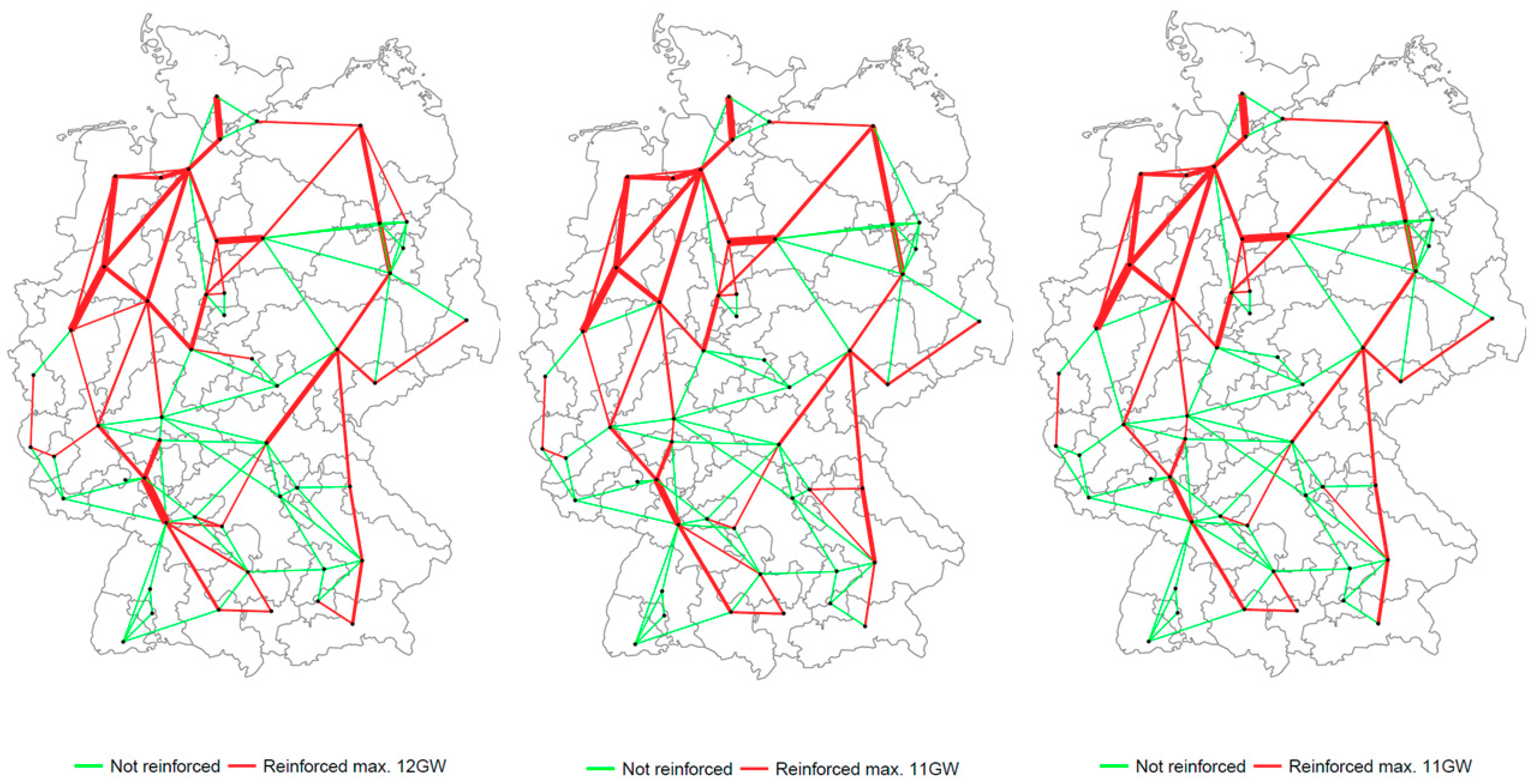
References
- European Union. Paris Agreement. Available online: https://ec.europa.eu/clima/policies/international/negotiations/paris_en (accessed on 3 August 2020).
- European Comission. Communication from the commission to the European Parliament, the European Council, the Council, the European Economic and Social Committee and the Committee of the Regions. The European Green Deal. 2019. Available online: https://eur-lex.europa.eu/legal-content/EN/TXT/?uri=COM%3A2019%3A640%3AFIN (accessed on 30 July 2020).
- ICLEI—Local Governments for Sustainability. Local and Regional Governments and ICLEI. Available online: https://iclei.org/en/our_network.html (accessed on 20 August 2020).
- Hohmeyer, O.H.; Bohm, S. Trends toward 100% renewable electricity supply in Germany and Europe: A paradigm shift in energy policies. Wires Energy Environ. 2015, 4, 74–97. [Google Scholar] [CrossRef]
- Senkpiel, C.; Shammugam, S.; Biener, W.; Hussein, N.S.; Kost, C.; Kreifels, N.; Hauser, W. Concept of evaluating chances and risks of grid autarky. In Proceedings of the 2016 13th International Conference on the European Energy Market (EEM), Porto, Portugal, 6–9 June 2016; IEEE: Piscataway, NJ, USA, 2016; pp. 1–5, ISBN 978-1-5090-1298-5. [Google Scholar]
- Hauber, J.; Ruppert-Winkel, C. Moving towards Energy Self-Sufficiency Based on Renewables: Comparative Case Studies on the Emergence of Regional Processes of Socio-Technical Change in Germany. Sustainability 2012, 4, 491–530. [Google Scholar] [CrossRef]
- Waenn, A.; Connolly, D.; Gallachóir, B.Ó. Investigating 100% renewable energy supply at regional level using scenario analysis. Int. J. Sustain. Energy Plan. Manag. 2014, 3, 21–32. [Google Scholar] [CrossRef]
- Jurasz, J.K.; Dąbek, P.B.; Campana, P.E. Can a city reach energy self-sufficiency by means of rooftop photovoltaics? Case study from Poland. J. Clean. Prod. 2020, 245, 118813. [Google Scholar] [CrossRef]
- Doering, M. Assessment of Storage Options for Reduction of Yield Losses in a Region with 100% Renewable Electricity. Energy Procedia 2015, 73, 218–230. [Google Scholar] [CrossRef][Green Version]
- Morel, J.; Obara, S.Y.; Morizane, Y. Operation Strategy for a Power Grid Supplied by 100% Renewable Energy at a Cold Region in Japan. J. Sustain. Dev. Energy Water Environ. Syst. 2014, 2, 270–283. [Google Scholar] [CrossRef]
- Child, M.; Bogdanov, D.; Breyer, C. The Baltic Sea Region: Storage, grid exchange and flexible electricity generation for the transition to a 100% renewable energy system. Energy Procedia 2018, 155, 390–402. [Google Scholar] [CrossRef]
- Weimer-Jehle, W.; Buchgeister, J.; Hauser, W.; Kosow, H.; Naegler, T.; Poganietz, W.; Pregger, T.; Prehofer, S.; von Recklinghausen, A.; Schippl, J.; et al. Context scenarios and their usage for the construction of socio-technical energy scenarios. Energy 2016, 111, 956–970. [Google Scholar] [CrossRef]
- Deutschle, J.; Hauser, W.; Sonnberger, M.; Tomaschek, J.; Brodecki, L.; Fahl, U. Energie-Autarkie und Energie-Autonomie in Theorie und Praxis. Z. Energ. 2015, 39, 151–162. [Google Scholar] [CrossRef]
- Schmidt, J.; Schönhart, M.; Biberacher, M.; Guggenberger, T.; Hausl, S.; Kalt, G.; Leduc, S.; Schardinger, I.; Schmid, E. Regional energy autarky: Potentials, costs and consequences for an Austrian region. Energy Policy 2012, 47, 211–221. [Google Scholar] [CrossRef]
- Engelken, M.; Römer, B.; Drescher, M.; Welpe, I. Transforming the energy system: Why municipalities strive for energy self-sufficiency. Energy Policy 2016, 98, 365–377. [Google Scholar] [CrossRef]
- Ecker, F.; Hahnel, U.J.J.; Spada, H. Promoting Decentralized Sustainable Energy Systems in Different Supply Scenarios: The Role of Autarky Aspiration. Front. Energy Res. 2017, 5, 11. [Google Scholar] [CrossRef]
- Brodecki, L.; Tomaschek, J.; Wiesmeth, M.; Gutekunst, F.; Siebenlist, A.; Salah, A.; Baumann, M.; Graf, R.; Brethauer, L.; Horn, R.; et al. Analyse des Energie-Autarkiegrades unterschiedlich großer Bilanzräume mittels integrierter Energiesystemmodellierung. Forschungsbericht. 2017. Available online: https://www.google.com/url?sa=t&rct=j&q=&esrc=s&source=web&cd=1&ved=2ahUKEwjnyYmSmKXjAhUBaFAKHS5eCuIQFjAAegQIARAC&url=http%3A%2F%2Ffachdokumente.lubw.baden-wuerttemberg.de%2Fservlet%2Fis%2F122354%2Fbwe13033_bwe13034_final.pdf%3Fcommand%3DdownloadContent%26filename%3Dbwe13033_bwe13034_final.pdf%26FIS%3D203&usg=AOvVaw3P4buL_QB6BuCKd0TKx_bT (accessed on 8 July 2019).
- Seidl, R.; Von Wirth, T.; Krütli, P. Social acceptance of distributed energy systems in Swiss, German, and Austrian energy transitions. Energy Res. Soc. Sci. 2019, 54, 117–128. [Google Scholar] [CrossRef]
- Sovacool, B.K. Diversity: Energy studies need social science. Nature 2014, 511, 529–530. [Google Scholar] [CrossRef]
- Ringkjøb, H.-K.; Haugan, P.M.; Solbrekke, I.M. A review of modelling tools for energy and electricity systems with large shares of variable renewables. Renew. Sustain. Energy Rev. 2018, 96, 440–459. [Google Scholar] [CrossRef]
- Alcamo, J. Scenarios as Tools for International Environmental Assessments; The Official Publications Office of the European Communities: Luxembourg, 2001. [Google Scholar]
- Weimer-Jehle, W. Cross-impact balances: A system-theoretical approach to cross-impact analysis. Technol. Forecast. Soc. Chang. 2006, 73, 334–361. [Google Scholar] [CrossRef]
- Kosow, H. The Best of both Worlds? An Exploratory Study on Forms and Effects of New Qualitative-Quantitative Scenario Methodologies. 2016. Available online: https://elib.uni-stuttgart.de/bitstream/11682/9032/1/Kosow_2016_The_best_of_both_worlds_Dissertation.pdf (accessed on 28 March 2019).
- Schweizer, V.J.; O’Neill, B.C. Systematic construction of global socioeconomic pathways using internally consistent element combinations. Clim. Chang. 2014, 122, 431–445. [Google Scholar] [CrossRef]
- Drakes, C.; Laing, T.; Kemp-Benedict, E.; Cashman, A. Caribbean Scenarios 2050: GoLoCarSce Report. Cermes Tech. Rep. 2017, 82, 33. [Google Scholar]
- Vögele, S.; Rübbelke, D.; Govorukha, K.; Grajewski, M. Socio-technical scenarios for energy-intensive industries: The future of steel production in Germany. Clim. Chang. 2019, 45, 786. [Google Scholar] [CrossRef]
- Weimer-Jehle, W.; Prehofer, S.; Vögele, S.; Buchgeister, J.; Hauser, W.; Kopfmüller, J.; Naegler, T.; Poganietz, W.-R.; Pregger, T.; Rösch, C.; et al. Context scenarios -A concept for coping with context uncertainty and complexity and its applications in the Helmholtz Research Alliance ENERGY-TRANS. In Die Energiewende Verstehen –Orientieren –Gestalten. Erkenntnisse aus der Helmholtz-Allianz ENERGY-TRANS.; Schippl, J., Grunwald, A., Renn, O., Eds.; Nomos Verlagsgesellschaft: Baden-Baden, Germany, 2017. (In German) [Google Scholar]
- Breyer, C.; Müller, B.; Möller, C.; Gaudchau, E.; Schneider, L. Vergleich und Optimierung von zentral und dezentral orientierten Ausbaupfaden zu einer Stromversorgung aus Erneuerbaren Energien in Deutschland. 2013. Available online: https://www.bvmw.de/fileadmin/pdf-archiv/Studie_zur_dezentralen_Energiewende.pdf.pdf (accessed on 11 January 2019).
- Peter, S. Modellierung Einer Vollständig auf Erneuerbaren Energien Basierenden Stromerzeugung im Jahr 2050 in Autarken, Dezentralen Strukturen. Climate Change. 2013. Available online: http://www.uba.de/uba-info-medien/4572.html (accessed on 25 January 2019).
- Matthes, F.C.; Flachsbarth, F.; Vogel, M.; Cook, V. Decentralization, Regionalization and Power Lines. Metastudy about Assumptions, Insights and Narratives. 2018. Available online: https://www.oeko.de/fileadmin/oekodoc/Decentralization-regionalization-and-power-lines.pdf (accessed on 11 January 2019).
- Kubli, M.; Ulli-Beer, S. Decentralisation dynamics in energy systems: A generic simulation of network effects. Energy Res. Soc. Sci. 2016, 13, 71–83. [Google Scholar] [CrossRef]
- Weimer-Jehle, W.; Kosow, H. Gesellschaftliche Kontextszenarien als Ausgangspunkt für modellgestützte Energieszenarien; KIT Scientific Publishing: Karlsruhe, Germany, 2011. [Google Scholar]
- Weimer-Jehle, W. Key Figures Used in the Analysis of CIB Scenarios: Cross-Impact Balance Analysis—Guideline no. 4. Available online: http://cross-impact.de/Ressourcen/Guideline_No_4.pdf (accessed on 28 March 2019).
- Le Roux, B.; Rouanet, H. Multiple Correspondence Analysis; SAGE Publications, Inc.: Thousand Oaks, CA, USA, 2010; ISBN 9781412968973. [Google Scholar]
- Fraunhofer, I.S.E. Power System Model for Expansion Planning and Unit-Commitment. Available online: https://www.ise.fraunhofer.de/en/business-areas/energy-system-technology/energy-system-analysis/energy-system-models-at-fraunhofer-ise/entigris.html (accessed on 14 August 2020).
- Kost, C. Renewable Energy in North Africa: Modelling of Future Electricity Scenarios and the Impact on Manufacturing and Employment. 2015. Available online: http://publica.fraunhofer.de/eprints/urn_nbn_de_0011-n-3563620.pdf (accessed on 27 March 2017).
- Kost, C.; Hartmann, N.; Senkpiel, C.; Schlegl, T.; Zampara, M.; Capros, P. Resdegree. Towards an Energy System in Europe Based on Renewables—Model Based Analysis of Greece and Germany by Coupling a European wide Demand and Supply Model (PRIMES) with a Regional and Temporal High Resolution Bottom-up Investment and Unit-Commitment Model (RESlion). 2015. Available online: http://www.e3mlab.eu/e3mlab/index.php?option=com_content&view=article&id=513:2014-2015-qres-degreeq&catid=38:energy-policy-projects&Itemid=59&lang=en (accessed on 21 August 2020).
- Reeg, M.; Nienhaus, K.; Pfenning, U.; Roloff, N.; Hauser, W.; Wassermann, S.; Weimer-Jehle, W.; Klann, U.; Kast, T. AMIRIS—An Agent-based Simulation Model for the Analysis of Market Integration of Renewable Energy under various Policy Frameworks. In Proceedings of the 2012 23rd International Workshop on Database and Expert Systems Applications, Vienna, Austria, 3–7 September 2012. [Google Scholar]
- Pfenninger, S.; Staffell, I. Long-term patterns of European PV output using 30 years of validated hourly reanalysis and satellite data. Energy 2016, 114, 1251–1265. [Google Scholar] [CrossRef]
- Hülk, L.; Wienholt, L.; Cußmann, I.; Müller, U.P.; Matke, C.; Kötter, E. Allocation of annual electricity consumption and power generation capacities across multiple voltage levels in a high spatial resolution. Int. J. Sustain. Energy Plan. Manag. 2017, 13, 79–92. [Google Scholar] [CrossRef]
- Biener, W.; Senkpiel, C.; Shammugam, S.; Garcia Rosas, K.R.; Linke, M.; Eibl, O. Impact of grid reduction on modelling accuracy of line usage rates. J. Phys. Conf. Ser. 2018, 977, 12001. [Google Scholar] [CrossRef]
- Bauckhage, C. NumPy/SciPy Recipes for Data Science: K-Medoids Clustering; Technical Report; University of Bonn: Bonn, Germany, 2015. [Google Scholar]
- Görner, K.; Sauer, D.U. Konventionelle Kraftwerke. Technologiesteckbrief zur Analyse, Flexibilitätskonzepte für die Stromversorgung 2050. 2017. Available online: http://www.acatech.de/fileadmin/user_upload/Baumstruktur_nach_Website/Acatech/root/de/Publikationen/Materialien/ESYS_Technologiesteckbrief_Konventionelle_Kraftwerke.pdf (accessed on 28 March 2018).
- Jülch, V. Comparison of electricity storage options using levelized cost of storage (LCOS) method. Appl. Energy 2016, 183, 1594–1606. [Google Scholar] [CrossRef]
- Kost, C.; Shammugam, S.; Jülch, V.; Nguyen, H.-T.; Schlegl, T. Studie: Stromgestehungskosten Erneuerbare Energien (März 2018). 2018. Available online: https://www.ise.fraunhofer.de/content/dam/ise/de/documents/publications/studies/DE2018_ISE_Studie_Stromgestehungskosten_Erneuerbare_Energien.pdf (accessed on 22 March 2018).
- Pfenninger, S.; Keirstead, J. Renewables, nuclear, or fossil fuels? Scenarios for Great Britain’s power system considering costs, emissions and energy security. Appl. Energy 2015, 152, 83–93. [Google Scholar] [CrossRef]
- Fraunhofer, I.W.E.S. Windenergie Report Deutschland 2016. 2017. Available online: http://publica.fraunhofer.de/eprints/urn_nbn_de_0011-n-4456098.pdf (accessed on 13 October 2017).
- ÜNB. Netzentwicklungsplan Strom 2025, Version 2015. 2015. Available online: https://www.netzentwicklungsplan.de/sites/default/files/paragraphs-files/NEP_2025_1_Entwurf_Teil1_0.pdf (accessed on 27 April 2018).
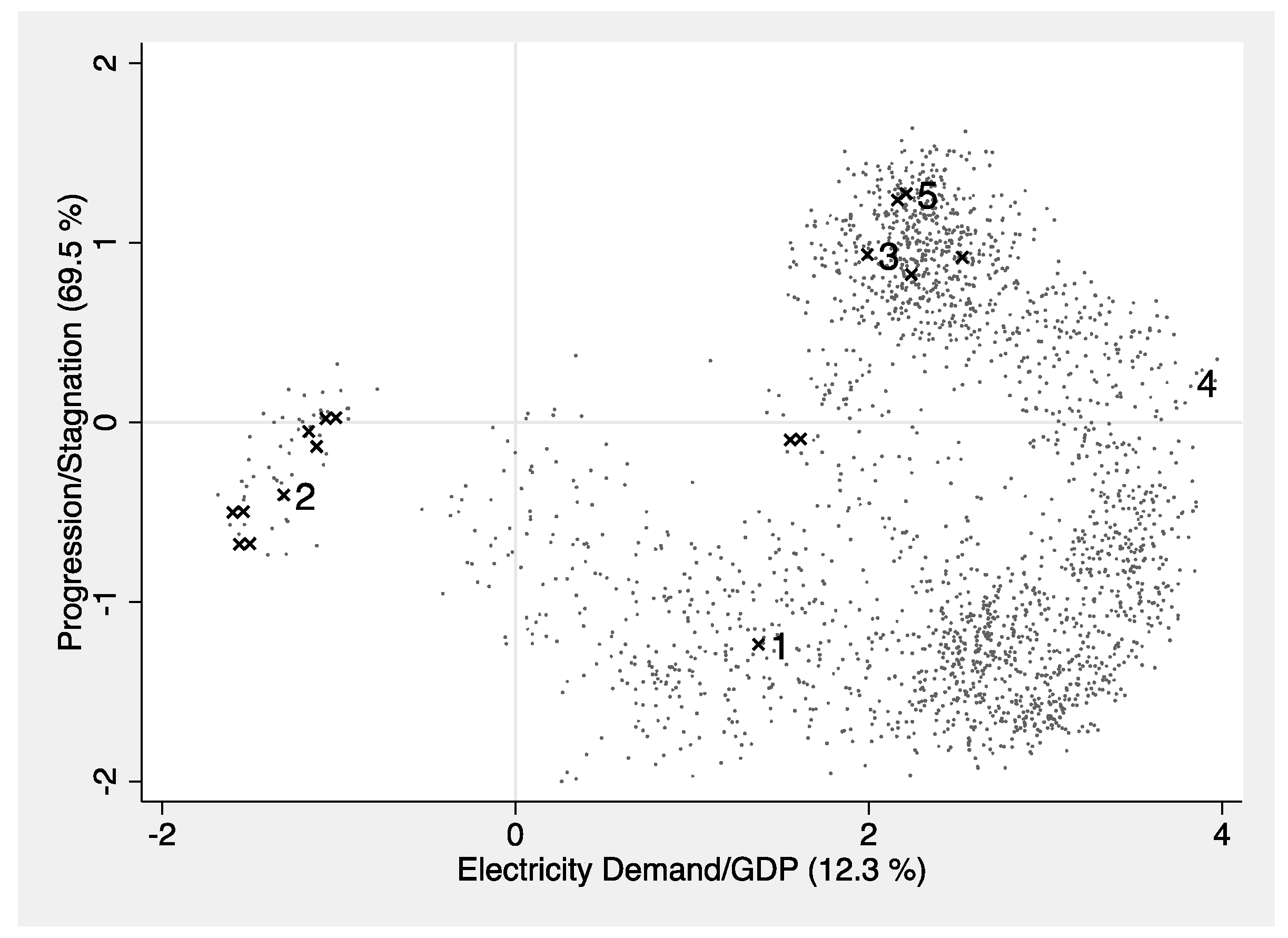
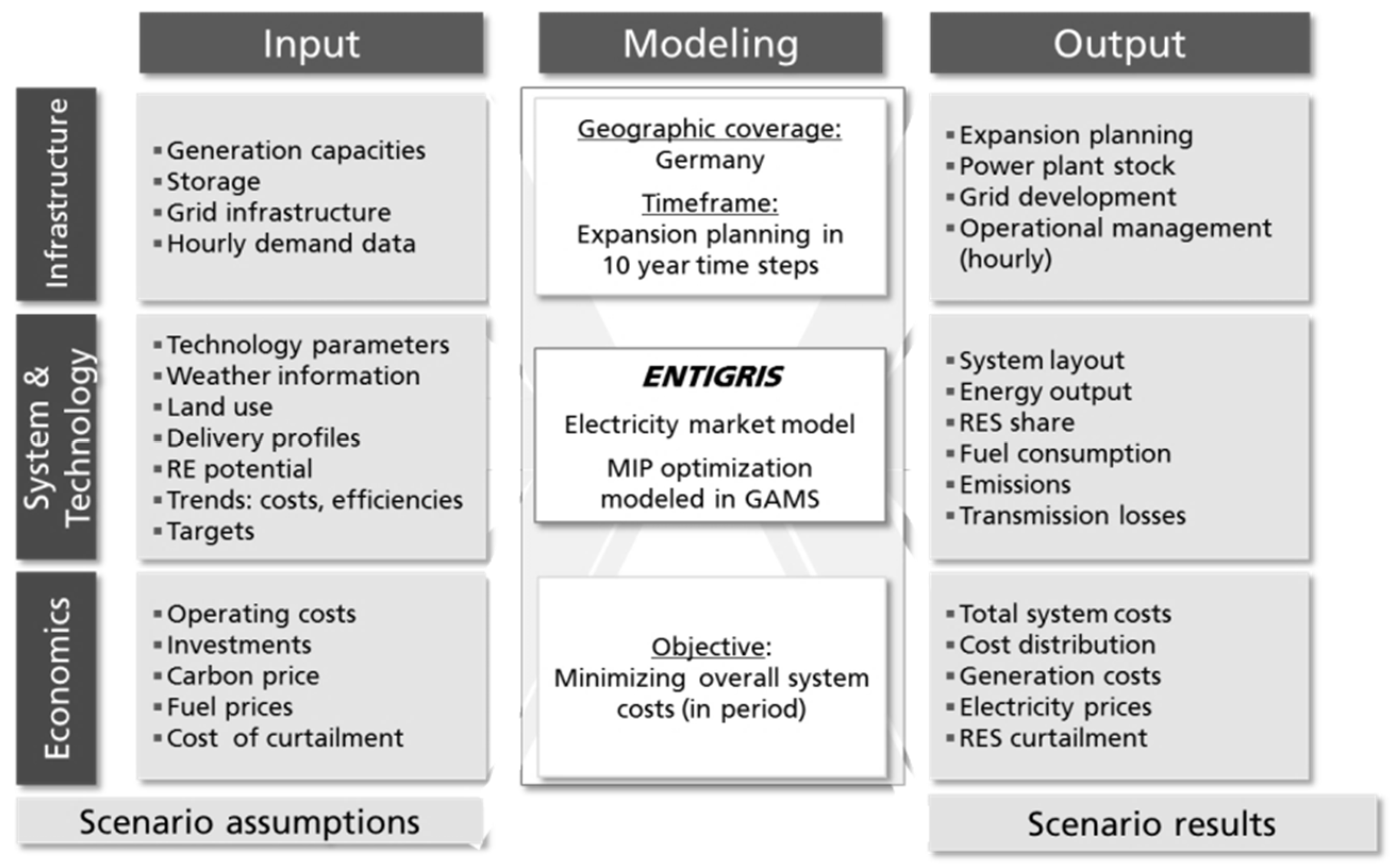
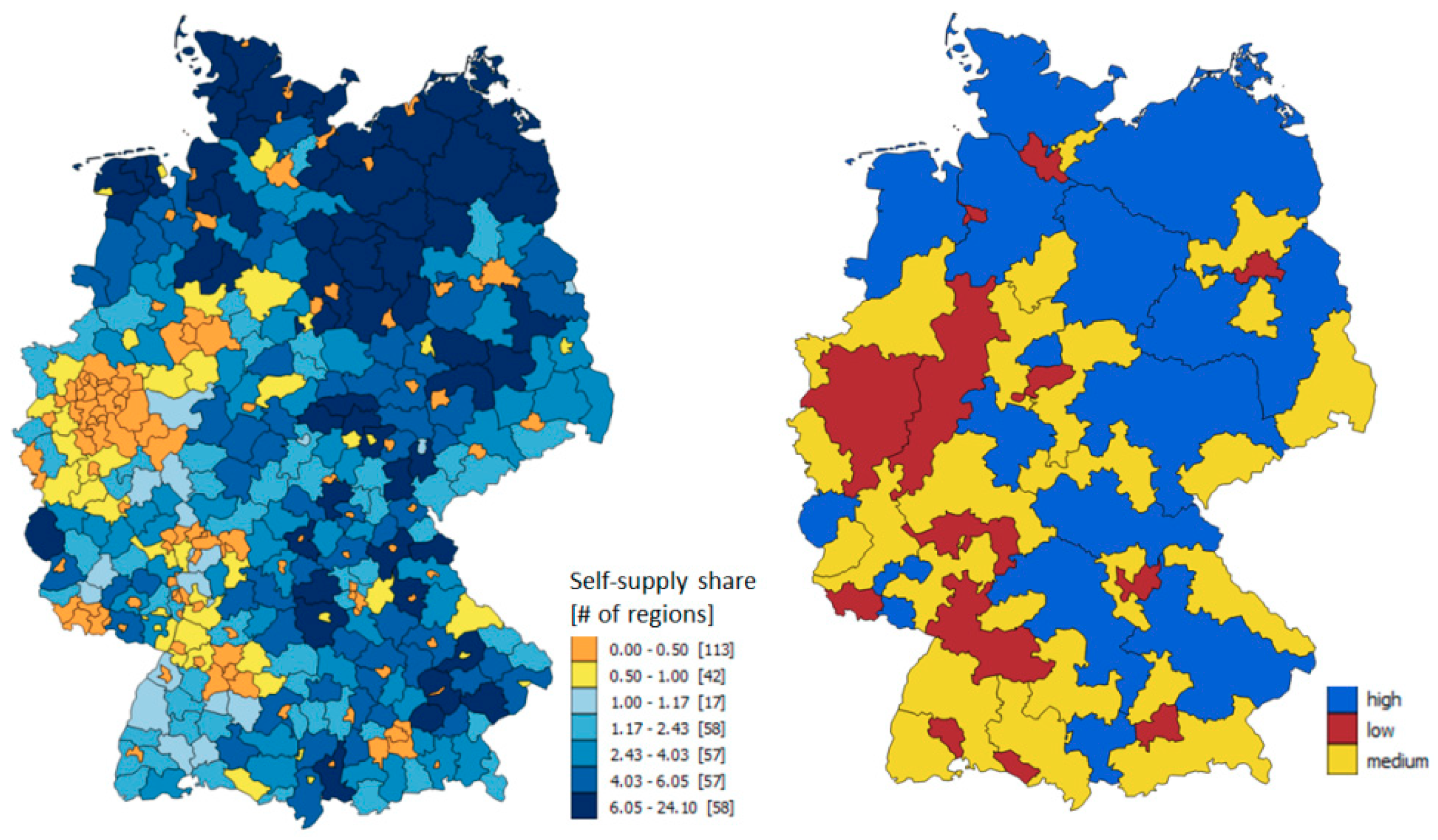
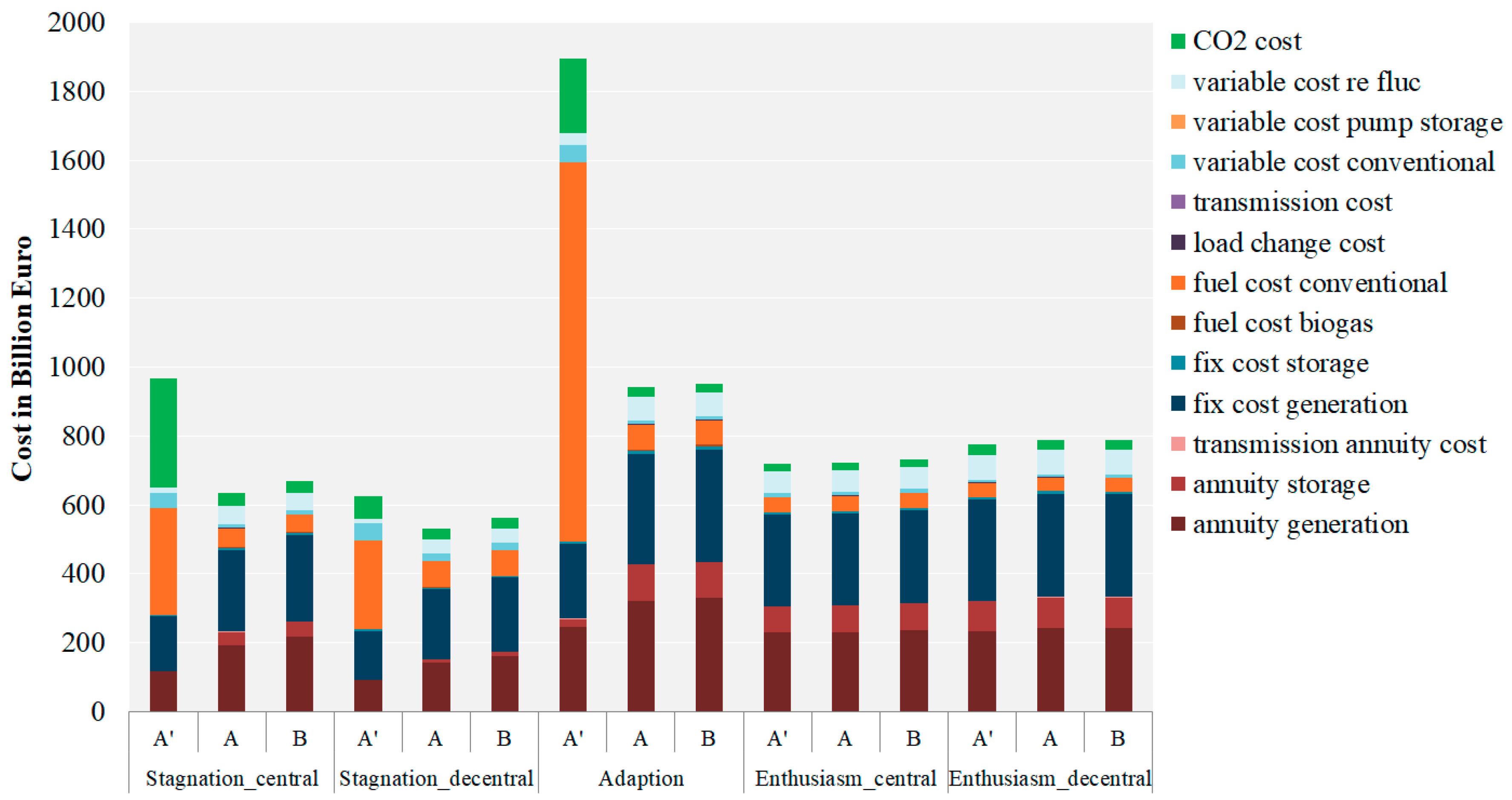
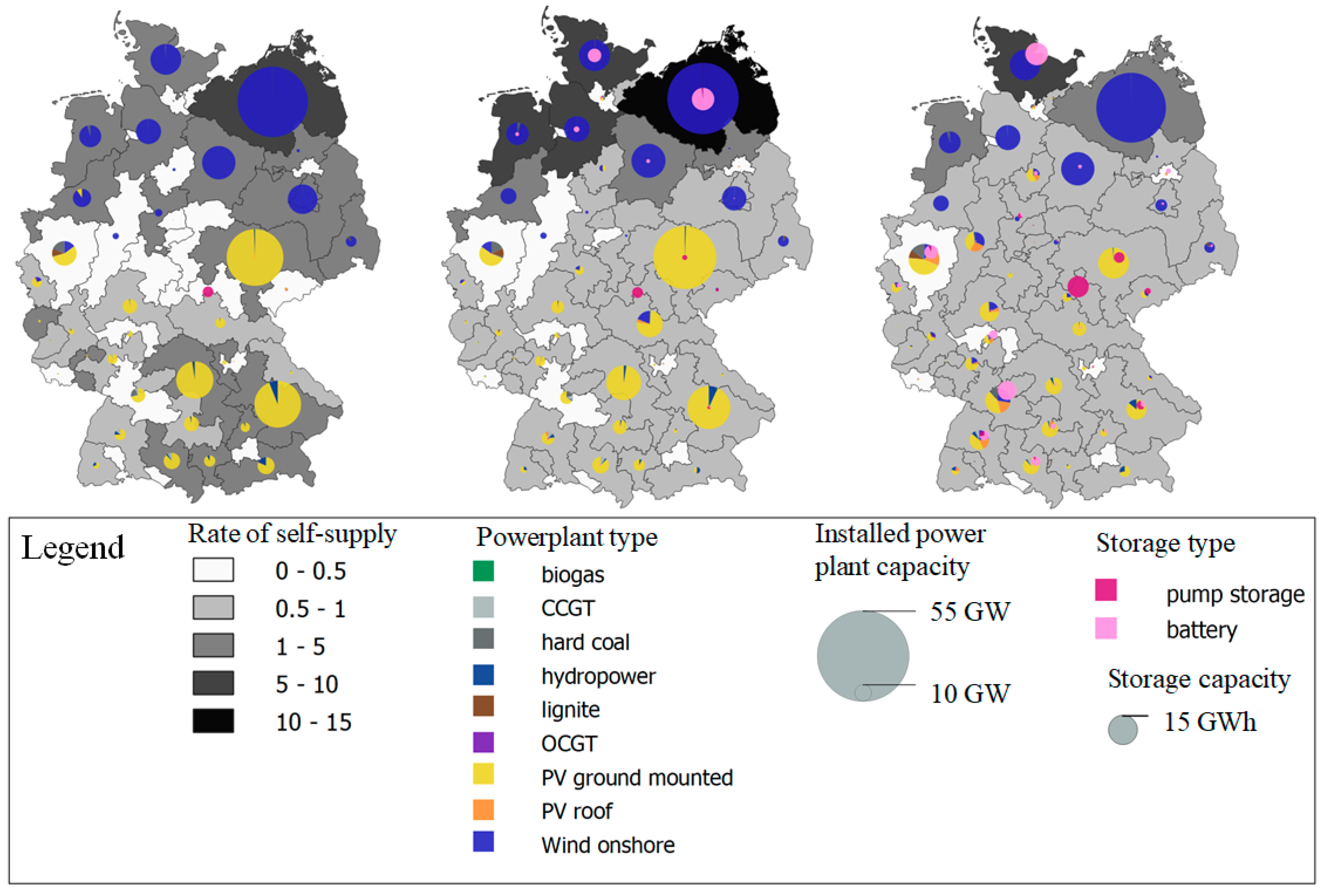
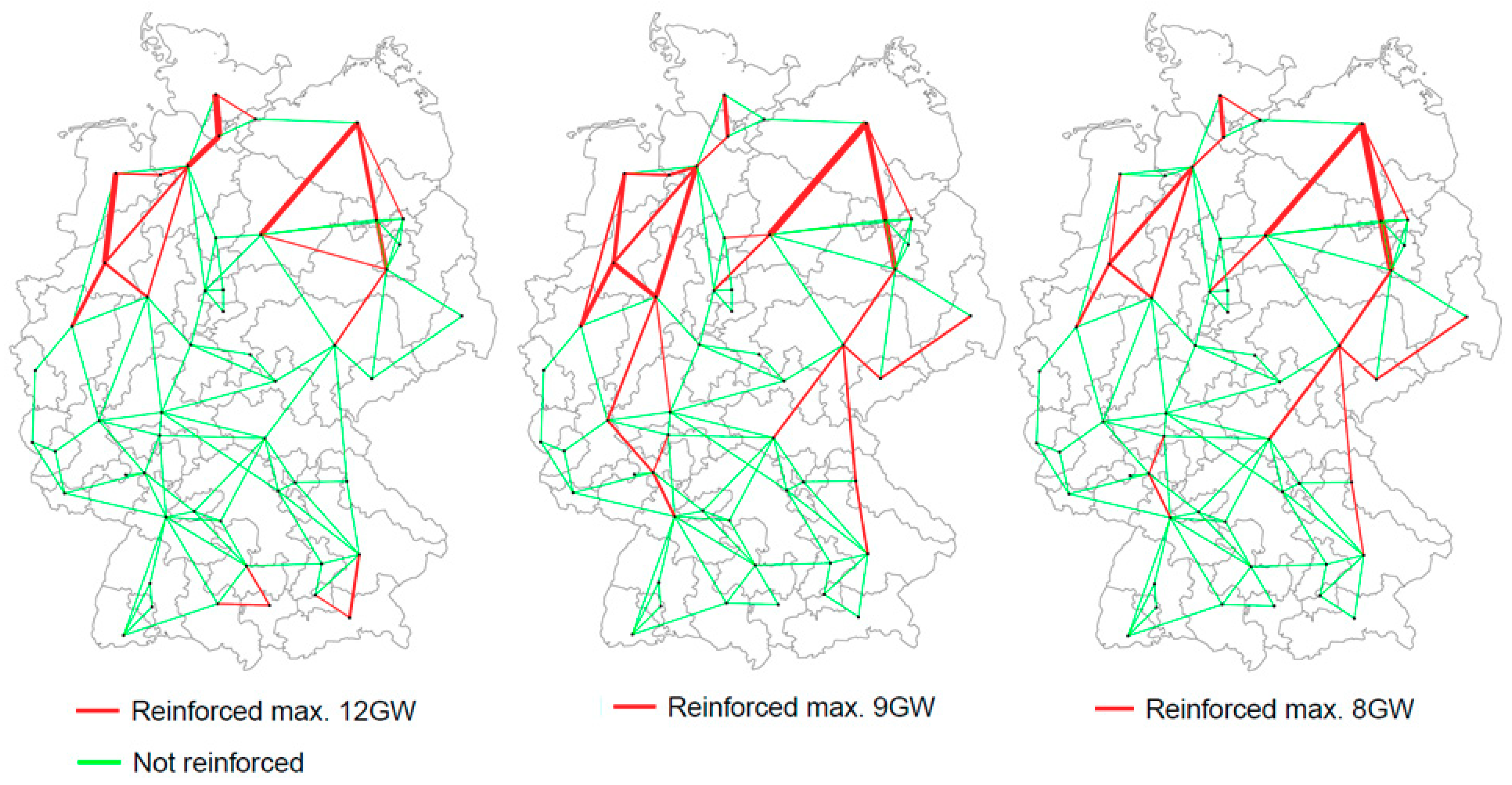
| Scenario Name | |||||
|---|---|---|---|---|---|
| Stagnation and Skepticism—Central (1) | Stagnation and Skepticism—Decentral (2) | Adaption and Optimism (3) | Completion and Enthusiasm—Central (4) | Completion and Enthusiasm—Decentral (5) | |
| Consistency | Fully Consistent | Fully Consistent | Fully Consistent | Inconsistency of 1 | Fully Consistent |
| Coupling Descriptors | |||||
| National renewable energy (RE) share in 2050 | low (60%) | low (60%) | medium (80%) | high (95%) | high (95%) |
| Global Fuel prices | low | low | high | medium | low |
| National CO2-price | high (200 €/ton) | low (20 €/ton) | medium (80 €/ton) | medium (80 €/ton) | high (200 €/ton) |
| National GDP | strong | weak | strong | moderate | strong |
| National electricity demand | decreasing (500 TWh) | decreasing (500 TWh) | increasing (800 TWh) | increasing (800 TWh) | strong increase (1.000 TWh) |
| Global CAPEX generation technologies | constant | moderate decrease | constant | moderate decrease | strong decrease |
| Global CAPEX storage | low decrease | low decrease | low decrease | strong decrease | strong decrease |
| Self-supply with electricity (low potential regions) | stagnation | medium—15% | medium—15% | medium—15% | medium—15% |
| Self-supply with electricity (medium potential regions) | medium—60% | medium—60% | medium—60% | medium—60% | high—100% |
| Self-supply with electricity (high potential regions) | medium—100% | medium—100% | high—200% | high—200% | high—200% |
| Qualitative Descriptors | |||||
| Public acceptance of energy transition | negative | negative | positive | positive | positive |
| Policy stability | higher | low | higher | higher | higher |
| Planning legislation | speeding up | legitimation/acceptance | legitimation/acceptance | speeding up | legitimation/acceptance |
| Importance of regional added value | decreasing | increasing | increasing | decreasing | increasing |
| Institutionalization of climate protection | centralization | re-municipalisation | re-municipalisation | centralization | re-municipalisation |
| Regional communitarisation | decreasing | enhancement | enhancement | decreasing | enhancement |
| Scenario Variation | Regional Self-Supply Targets | National RE Targets |
|---|---|---|
| A’ | Without targets | Defined as range (target + 5%) |
| A | With plausible targets (Table 1) (minimum constraint) | Defined as a minimum target |
| B | With 100% targets (minimum constraint) | Defined as a minimum target |
| Percentage Deviation of | Stagnation and Skepticism—Central | Stagnation and Skepticism—Decentral | Adaption and Optimism | Completion and Enthusiasm—Central | Completion and Enthusiasm—Decentral | ||||||||||
|---|---|---|---|---|---|---|---|---|---|---|---|---|---|---|---|
| A’ | A | B | A’ | A | B | A’ | A | B | A’ | A | B | A’ | A | B | |
| National RE-Share in 2050 [%] | 65 | 98 | 99 | 61 | 88 | 90 | 85 | 99 | 99 | 99 | 99 | 99 | 98 | 99 | 99 |
| Installed generation capacity (in 2050) | 1.32 ** | 1.49 ** | 1.22 ** | 1.34 ** | 1.12 ** | 1.14 ** | 1.01 | 1.00 | 1.03 | 1.02 | ||||||||||
| Installed flexibility capacity (in 2050) | 3.16 *** | 3.29 *** | 1.92 *** | 1.93 *** | 2.16 *** | 2.10 *** | 0.99 | 0.99 | 1.00 | 1.00 | ||||||||||
| CO2-emissions (all years) | 0.23 *** | 0.21 *** | 0.51 *** | 0.50 *** | 0.24 *** | 0.23 *** | 1.00 | 1.00 | 1.01 | 1.00 | ||||||||||
| Curtailment (in 2050) | 9.10 *** | 10.11 *** | 2.79 *** | 3.68 *** | 1.65 *** | 1.68 *** | 1.03 | 0.94 | 1.18 ** | 1.13 ** | ||||||||||
| Reinforced Grid capacity | 1.09 * | 0.64 ** | 1.01 | 0.36 ** | 0.76 ** | 0.64 ** | 0.79 ** | 0.63 ** | 0.87 ** | 0.86 ** | ||||||||||
| Number of reinforced grid lines | 1.07 *| 0.64 ** | 0.98 ** | 0.33 *** | 0.81 ** | 0.63 ** | 0.79 ** | 0.63 ** | 0.89 ** | 0.86 ** | ||||||||||
| Total system cost | 0.66 ** | 0.69 ** | 0.85 ** | 0.90 * | 0.50 *** | 0.50 *** | 1.00 | 1.02 | 1.02 | 1.02 | ||||||||||
| Generation Share in 2050 | Stagnation and Skepticism—Central | Stagnation and Skepticism—Decentral | Adaption and Optimism | Completion and Enthusiasm—Central | Completion and Enthusiasm—Decentral | ||||||||||
|---|---|---|---|---|---|---|---|---|---|---|---|---|---|---|---|
| Scenario Variant | A’ | A | B | A’ | A | B | A’ | A | B | A’ | A | B | A’ | A | B |
| biogas | 0.0 | 0.0 | 0.0 | 0.0 | 2.5 | 2.2 | 0.0 | 0.0 | 0.3 | 0.0 | 0.0 | 0.0 | 0.0 | 0.0 | 0.0 |
| ccgt | 35.0 | 0.1 | 0.1 | 28.4 | 5.5 | 5.0 | 8.7 | 0.3 | 0.3 | 0.3 | 0.3 | 0.3 | 0.1 | 0.1 | 0.1 |
| hardcoal | 0.1 | 1.6 | 1.0 | 8.3 | 4.6 | 3.5 | 4.9 | 0.2 | 0.2 | 0.6 | 0.8 | 0.6 | 1.5 | 1.0 | 1.1 |
| hydropower | 4.8 | 4.7 | 4.7 | 4.7 | 4.8 | 4.7 | 3.0 | 3.0 | 3.0 | 3.0 | 3.0 | 3.0 | 2.4 | 2.4 | 2.4 |
| lignite | 0.0 | 0.0 | 0.5 | 3.2 | 0.0 | 0.0 | 2.0 | 0.3 | 0.3 | 0.0 | 0.0 | 0.0 | 0.0 | 0.0 | 0.0 |
| PV gm | 12.2 | 15.8 | 20.0 | 23.4 | 22.6 | 19.2 | 19.4 | 25.8 | 24.0 | 35.8 | 35.8 | 31.0 | 37.9 | 35.1 | 33.1 |
| PV roof | 0.0 | 0.0 | 3.6 | 0.0 | 0.3 | 4.1 | 0.0 | 0.3 | 2.2 | 0.0 | 0.9 | 4.0 | 0.0 | 2.9 | 4.2 |
| wind onshore | 47.9 | 77.7 | 70.1 | 32.1 | 59.7 | 61.3 | 62.0 | 70.1 | 69.7 | 60.3 | 59.3 | 61.1 | 58.1 | 58.5 | 59.2 |
| Curtailment (% of total generation) | 1 | 7 | 7 | 2 | 6 | 7 | 4 | 7 | 7 | 6 | 6 | 6 | 9 | 11 | 11 |
| Storage use(% of total generation) | 0 | 9 | 10 | 0 | 5 | 5 | 6 | 12 | 12 | 16 | 16 | 16 | 16 | 16 | 16 |
| Stagnation and skepticism—Central | Stagnation and skepticism—Decentral | Adaption and Optimism | Completion and Enthusiasm—Central | Completion and Enthusiasm—Decentral | |||||||||||
|---|---|---|---|---|---|---|---|---|---|---|---|---|---|---|---|
| Scenario Variant | A’ | A | B | A’ | A | B | A’ | A | B | A’ | A | B | A’ | A | B |
| Cost in billion €2018 | 967 | 634 | 668 | 626 | 533 | 563 | 1894 | 940 | 953 | 721 | 724 | 733 | 775 | 788 | 788 |
| Cost €2018/capita/a | 389 | 255 | 269 | 252 | 215 | 227 | 763 | 378 | 384 | 290 | 292 | 295 | 312 | 317 | 317 |
| Cost in €cent2018/kWh | 6.5 | 4.2 | 4.5 | 4.2 | 3.6 | 3.8 | 9.7 | 4.8 | 4.9 | 3.7 | 3.7 | 3.8 | 3.4 | 3.5 | 3.5 |
© 2020 by the authors. Licensee MDPI, Basel, Switzerland. This article is an open access article distributed under the terms and conditions of the Creative Commons Attribution (CC BY) license (http://creativecommons.org/licenses/by/4.0/).
Share and Cite
Senkpiel, C.; Hauser, W. Systemic Evaluation of the Effects of Regional Self-Supply Targets on the German Electricity System Using Consistent Scenarios and System Optimization. Energies 2020, 13, 4695. https://doi.org/10.3390/en13184695
Senkpiel C, Hauser W. Systemic Evaluation of the Effects of Regional Self-Supply Targets on the German Electricity System Using Consistent Scenarios and System Optimization. Energies. 2020; 13(18):4695. https://doi.org/10.3390/en13184695
Chicago/Turabian StyleSenkpiel, Charlotte, and Wolfgang Hauser. 2020. "Systemic Evaluation of the Effects of Regional Self-Supply Targets on the German Electricity System Using Consistent Scenarios and System Optimization" Energies 13, no. 18: 4695. https://doi.org/10.3390/en13184695
APA StyleSenkpiel, C., & Hauser, W. (2020). Systemic Evaluation of the Effects of Regional Self-Supply Targets on the German Electricity System Using Consistent Scenarios and System Optimization. Energies, 13(18), 4695. https://doi.org/10.3390/en13184695




